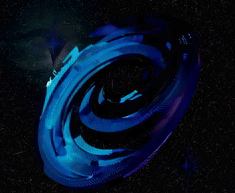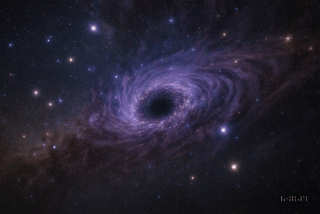Inspired by: Issac Newton, Albert Einstein, Stephen Hawkings, Roger Penrose, and Kip Thorne, Shep Doeleman, Andrea Ghez, Juan Madacena, and Sabine Hossenfelder, Wolfgang Rindler, Roy Kerr
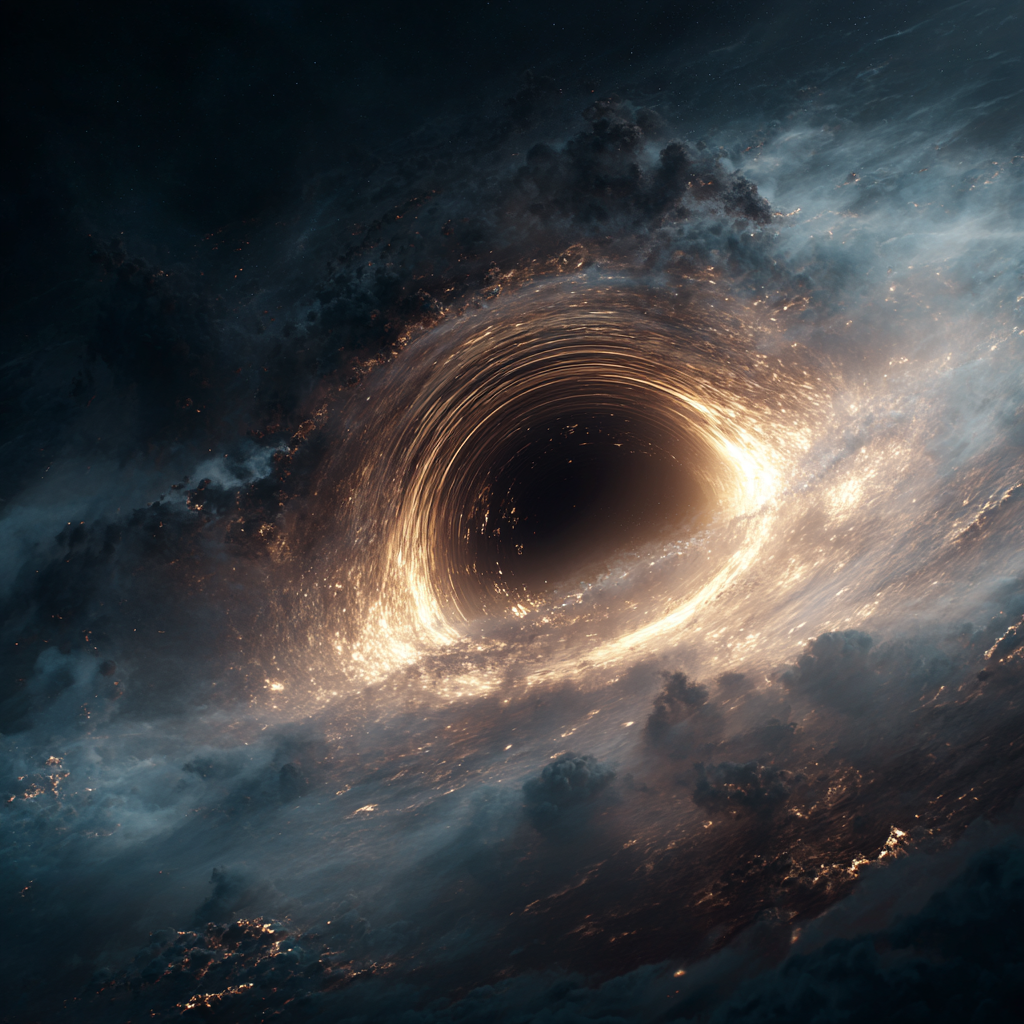
What is a Black Hole?
A Black Hole is a region of space-time that is so dense that nothing can escape. This boundary, where all objects, including light get trapped by the black hole’s gravity, is called the Event Horizon. It is currently an unexplained phenomena in physics.
We know a lot about how Black Holes: their structures, lifespans, and diversity, but we still can’t explain what is actually happening beyond the Event Horizon. It is still a giant mystery how they work, especially in terms of how their light-speed polar jets jets and massive, flat accretion disks function.
How does a Black Hole Form
Black Holes form when a giant star collapses, usually an O type star or a late stage B type star. Currently Black Hole formation is hotly debated because the James Webb telescope is finding Black Holes that are way too big for our current modeling of the age of the universe. It is truly a giant mystery how some of the older, supermassive, black holes have grown to their current, massive sizes, and defies the current physics of super Eddington Accretion. The black holes simply got too big, too fast for our current understanding of the physics and evolution of black holes to be anywhere near correct.
The Structure of a Black Hole
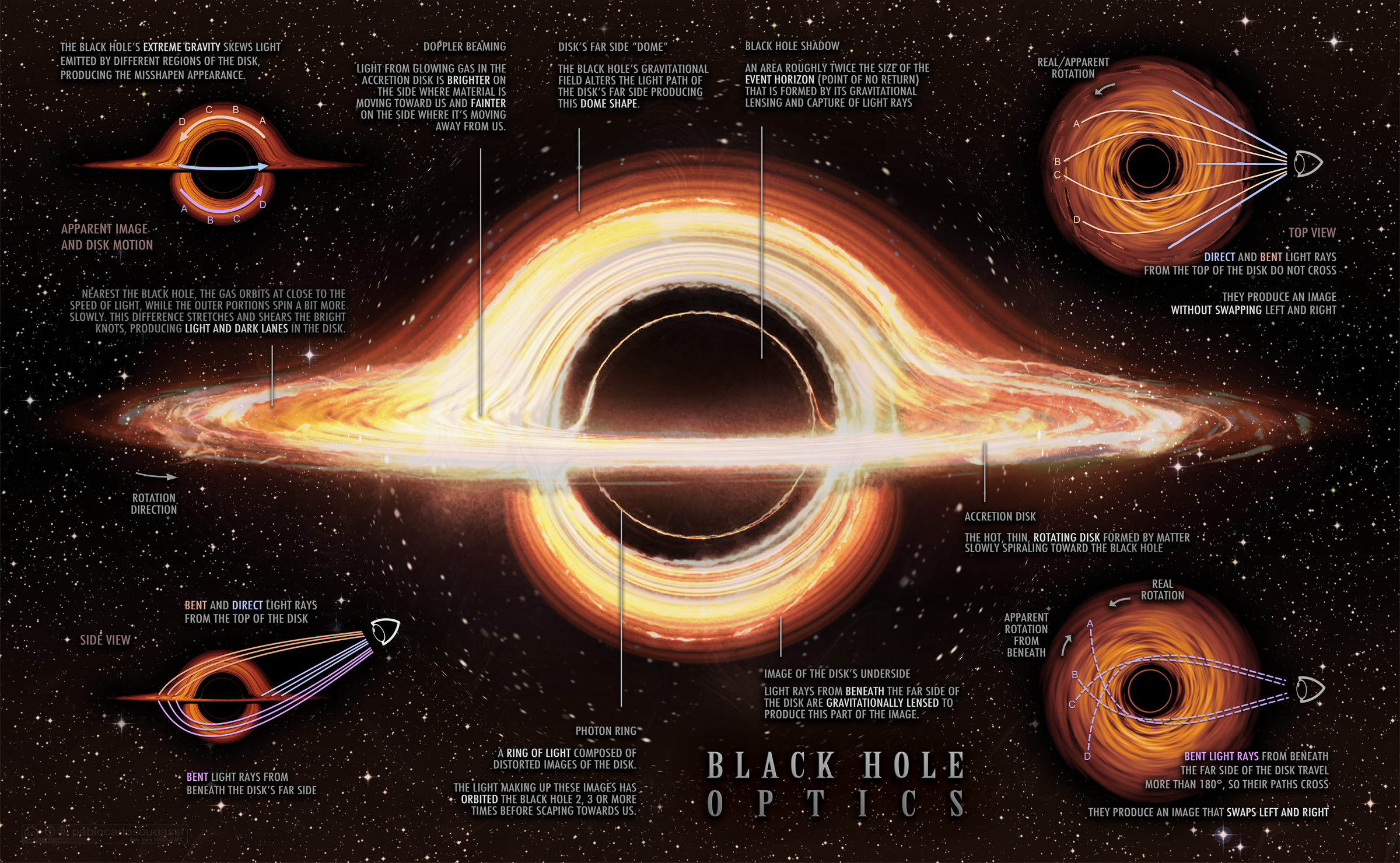
Event Horizon
The event horizon is the black hole boundary where nothing can escape, not even light because the gravity of the black hole exceeds the escape velocity of the speed of light. To an outside observer, the black hole’s gravity would dilate time so much that any object falling into the black hole would seem to freeze, shift to red, and then disappear.
Singularity
Beyond the Event Horizon is a mystery, but there is believed to be a central point to a black hole of infinite density. This however, is unlikely, and the true mechanics of the singularity, if such a thing even exists, are currently unknown and completely speculative because of the lacking of a good theory of quantum gravity. It is simply beyond our ability to measure currrently, although LIGO, EHT, and Chaundra’s X-Ray are all working on understanding how these massive, possibly infinitely dense objects function.
Accretion Disk
The accretion disk of a Black Hole is relatively well understood. These are some of the most extreme environments in the universe, a swirling plasma hurricane of super heated dust gas spiraling inwards towards its demise, creating some of the brightest objects in the sky.
Matter rarely ever falls directly into a black hole. Everything has rotation in space, black holes are no exception! The angular momentum (sideways) creates the disk structure, usually there is a companion object that is feeding the black hole, like a Lyman alpha blob, a companion star, or smaller black hole, debris from older stars, supernovae, or a tidal disruption event where the black hole literally rips apart a star.
Ergosphere
The ergosphere is one of the strangest areas in the known universe – a zone around rotating black holes where spacetime itself is being dragged around so violently that nothing can stand still, even light!
It exists outside the event horizon, making it a place you could theoretically visit and escape from (though you’d have quite a wild ride). Time dilation eddies and swirls of gravity would create all kinds of fascinating effects! The inner boundary is the event horizon, where time literally stand still. The outer boundary is the “static limit” or ergosurface.
ISCO – Innermost Stable Circular Orbit
The last stable orbit before the death plunge. For non-rotating black holes: 3x the Schwarzschild radius. For maximally rotating black holes: can be at the event horizon itself! Inside the ISCO, matter spirals in within milliseconds.
Photonsphere
This is mind-blowing: the photon sphere contains a complete visual history of everything that ever fell into the black hole. It is a fuzzy boundary full of chaotic orbits and trajectories near the event horizon.
The photon sphere is a spherical region around a black hole where gravity is exactly equalized to bend light into a circular orbit. It’s like a cosmic racetrack where photons can theoretically circle the black hole forever!
Technically, there are two photon spheres because all black holes rotate. The prograde photon sphere is closer to the black hole, and frame drags light to orbit, and is a smaller radius and orbit.
The retrograde photon sphere is further, fights the frame dragging of the prograge sphere, and has a large radius, sometime more than double the prograde photon sphere. When rotation is slower, they are closer together. So a faster rotating black hole has a wider event horizon, proton sphere, and accretion disk!
The future of the photon sphere is likely where we will get time machine technology, if it is possible. By viewing the light in the photon spheres of supermassive black holes, wecCould theoretically see ancient universe and recent universe in same view. The past and present would be superimposed.
The photon sphere is really where general relativity gets weird but still observable – it’s outside the event horizon so we can actually see its effects, but it’s close enough that spacetime is doing absolutely bonkers things to light. It’s the last place where physics is still “normal” enough to understand but extreme enough to be alien to anything in everyday experience!
Corona
The Black Hole Corona is another giant mystery of the environment, it is a giant cloud of extremely hot electrons that is typically at billions of degrees Kelvin and is much hotter than the disc below! We don’t understand the heating mechanism, likely because dark energy is involved, similar to the solar corona environment outside of a star.
Scientists debate the actual shape:
“Lamppost” Model:
Compact corona right above black hole’s poles like a lighthouse beacon situated 5-20 gravitational radii awayIlluminates disk from above
“Sandwich” Model:
Corona spread above and below entire inner disk like atmospheric layers with continuous coverage and varying thickness, viscosity, and temperature.
“Patchy” Model:
Multiple hot spots scattered around where magnetic flares create temporary coronae. This model is dynamic and changing, similar to clouds and storms in an atmosphere.
Hybrid Reality:
In reality, these models are proably all correct. The black holes evolve and change with accretion state, and every black hole is likely somewhat unique, due to its history, nearby stars and local environment. It is basically a soup of matter and antimatter, but we can’t quite measure anti-matter yet. Hopefully Cern and the LHC are able to in the next 10 years. There is also a lot of research being done on magnetic re-connection events, which is the leading theory for how these particles become so hot. A strong corona means strong jets, so it is likely that magnetic fields are involved that shock the system repeatedly, increase acceleration and phase transitions. Some of the coolest, most recent research has been around the jets based off the corona and examining their relationship. From NuStar (Nuclear Spectroscopic Telescope Array), we can see the corona collapse towards the black hole. IXPE (Imaging X-ray Polarimetry Explorer) is mapping the coronal geometry and the polarization of X-rays, and XRISM is measuring coronal velocities using high resolution spectroscopy. What they have found is a building up of the corona into jets, usually sporadic, but if there is enough energy, could supply the black hole with the energy it needs for steady jets, such as TON 618, which has a companion Lyman Alpha Blob that has powered it to be the largest black hole in the known universe. The size of a supermassive black hole’s corona could be the size of the solar system.
Light Speed Black Hole Jets
The Blandford-Znajek mechanism describes how an accretion disk becomes a jet. The Magnetic lines of the black hole become tangled over time due to frame dragging, and the relativistic effects of the massive gravity well of the black hole. The Ergosphere (and within the ergosphere, the corona) is incredibly important to this, as this is where the jets draws it power directly from. Hence, the presence (or not) of a poloidal magnetic field around the black hole is not determinant in its overall power output. It was also suggested that the mechanism plays a crucial role as a central engine for a gamma-ray burst, which represent the brightest and most powerful events in the universe.
Types of Black Holes
SuperMassive Black Holes
A supermassive black hole (SMBH) is a gargantuan type of black hole, with a mass ranging from millions to billions of times that of our Sun. These black holes are
found at the center of all large galaxies, including our Milky Way’s Sagittarius A*. These cosmic dieties significantly influence their host galaxies, with their gravity affecting the orbits of the surrounding stars and gas. They are also capable of producing new stars, their activity, as active galactic nuclei (AGN), potentially powering the jets of particles that outshine the host galaxy. Scientists are still researching how they originate, but the leading theories are direct collapse of giant, heavy gas clouds, stellar collapse (supernovae), and stellar black hole mergers.
Intermediate Mass Black Holes
These black holes have yet to be detected. While their existence is still being confirmed, recent evidence from observations of fast-moving stars in the globular cluster Omega Centauri by NASA’s Hubble Space Telescope provides compelling support for their presence. Comprising about 10 million stars, it is the largest and brightest globular cluster in the Milky Way and is notable for potentially housing an intermediate-mass black hole at its core. They are described as being 100 to 10,000 times the size of the Sun.
Stellar Black Holes
These black holes form from Supernovae up to 100 times the size of the sun. Only O type stars and some B types stars can become black holes, and it depends on the density of the stellar core if the Tolman-Oppenheimer-Volkoff (TOV) limit is the theoretical maximum mass for a cold, non-rotating neutron star before it collapses into a black hole.
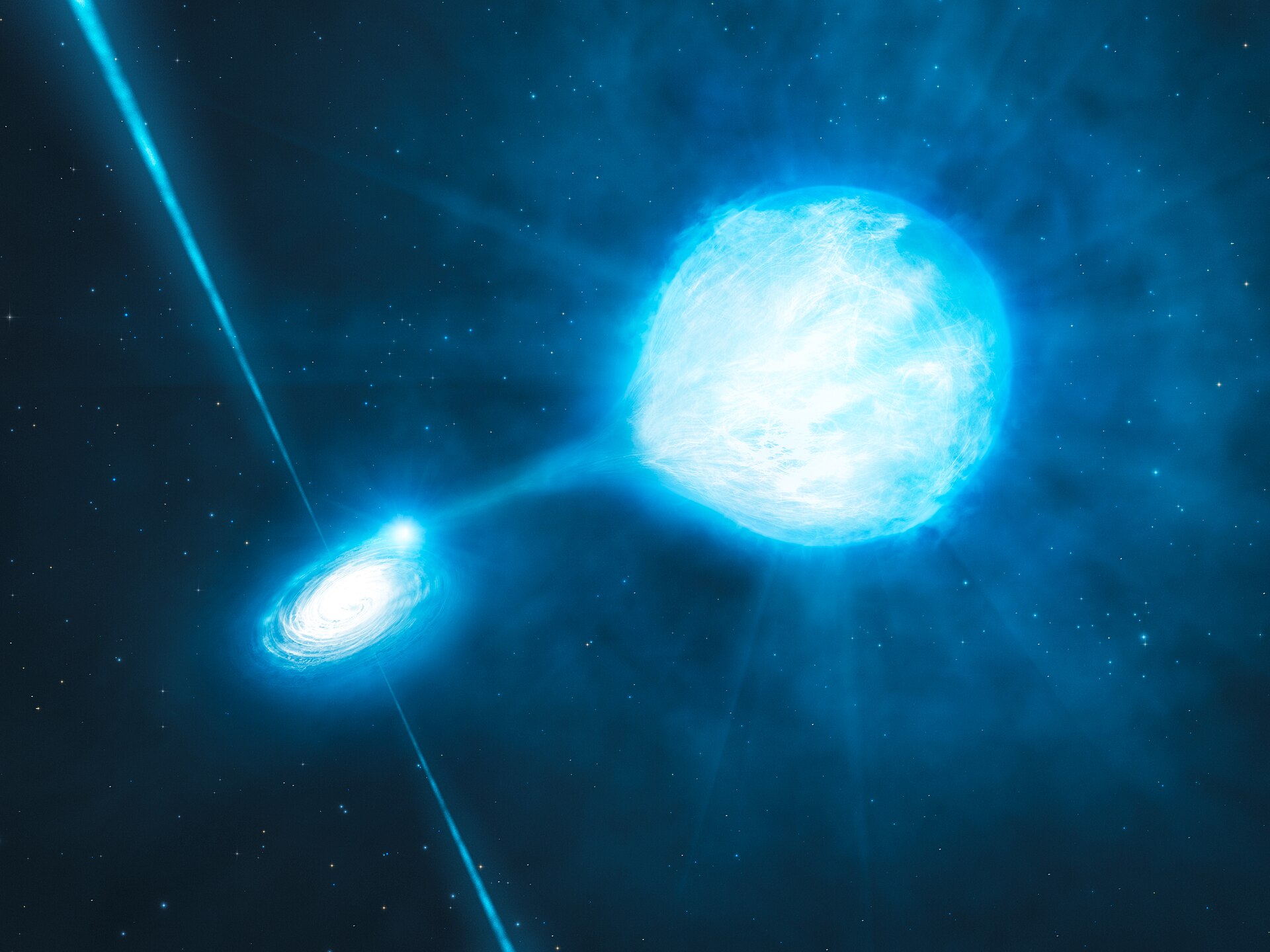
Primordial Black Holes
These are hypothetical objects scientist believe were formed by the big bang. It explains how some black holes are the mass that we observe (it should be theoretically impossible for many of the larger black holes we have found to be able to exist! Because they are too big!)
Do Black Holes Die?
Yes, Black Holes Die through Hawking radiation! Stephen Hawking proved in 1974 that black holes evaporate over time. The time scales break down when we try to understand them, but essentially black holes are immortal on human timescales, and probably we don’t understand them too well yet.
How do we detect Black Holes if they are invisible?
Black Holes are inferred from their surrounding environment, specifically the accretion disc and ergosphere. We use X-Rays to measure the radiation output, but the cutting edge is actually measure gravitational waves with LIGO, which is a large undergound laser than can detect gravitational anomalies and ripples in spacetime using laser interferometry.
Black Hole Physics
As predicted by Einstein’s theory of general relativity, Black Holes have mass squeezed into an incredibly tiny space, creating their extreme gravitational fields. They exert extreme tidal forces and smaller black holes seem to be more extreme tides than the larger ones. They all rotate, and are relatively flat, so the poles of the black hole are incredibly important for energy release, as exhibited by hardonic jets only happening on the poles. This suggest more exotic physics that what we currently know, probably magnetically charged sub-atomic particles, dark energy, and exotic physics that haven’t been discovered yet.
What Happens Inside of a Black Hole?
Inside of the black hole is a mystery, but they idea is that gravity would become so extremely that it would tear your body into little shred of spaghetti. Although I don’t really think that would be possible, it is important to understand how intense gravity is here. Time dilation could reverse inside of the event horizon! It could be a link to the big bang! There are some many possibilities, its really hard to rule things out! One thing is for sure; its worth studying!
Black Hole and the Universe: their role in Galaxies, Quasars, and Active Galactic Nuclei
Black Holes are at the center of literally every known galaxy. They power Quasars and Active Galactic Nuclei, and are crucial for galactic evolution. They interact powerfully with their host galaxies in a feedback loop; they evolve together. Because Quasars are so bright, they tell us a lot about the history of their light, and therefore of the universe. The swirls that you see in a galaxy are directly caused by the angular momentum of the black hole! Some Active Galatic Nuclei launch powerful jets traveling at nearly the speed of light!
Famous Black Holes that you should know about
Ton 618

TON 618 isn’t just a black hole—it’s a hyperluminous quasar, one of the brightest in the universe, found in the constellations of Canes Venatici and Coma Berenices. At a redshift of 2.219, its light has been traveling for billions of years—reflecting its immense distance from Earth (~18.2 billion light-years) . Its brightness is staggering, with an absolute magnitude of around −30.7, making it as luminous as 140 trillion Suns .
Titanic Mass: The Heavyweight Champion of Black Holes
TON 618’s central black hole is one of the most massive ever observed. Estimates range from 40 billion to 66 billion solar masses:
- Many sources cite roughly 66 billion times the Sun’s mass, making it arguably the most massive known .
- Other reputable estimates place it around 40 billion solar masses, still extraordinary by any measure . Both ranges firmly position TON 618 as a supermassive, even ultra‑massive black hole.
Enormous Size: Imagine the Solar System Inside It
With a Schwarzschild radius of about 1,300 astronomical units (AU)—nearly 195 billion km—TON 618’s event horizon would dwarf our solar system (Neptune orbits at roughly 30 AU) . In diameter, it spans 30–40 times the width of our solar system .
Recorded in History: From Observatory to Quasar
TON 618 was first cataloged in 1957 at Mexico’s Tonantzintla Observatory, identified as faint blue object number 618—hence the name TON 618 . Its true nature as a radio-loud quasar emerged in the 1970s through spectroscopic studies that revealed hugely redshifted emission lines .
Surrounding Giant Lyman-Alpha Nebula (LAB)
TON 618 isn’t alone—it’s embedded in a massive Lyman‑alpha blob, a glowing nebula composed of hydrogen gas spanning at least 100 kiloparsecs (twice the diameter of the Milky Way) . Observations show two massive components—an inner molecular outflow and extensive cold gas in its circumgalactic medium, each weighing as much as 50 billion solar masses, aligned with the quasar’s radio jets .
6. Insight into Galaxy Evolution
As both a quasar and a Lyman‑alpha blob, TON 618 provides astronomers with invaluable data about how massive galaxies and their central black holes formed in the early universe—probing the dynamics of ionization, gas dynamics, and galaxy assembly .
Cygnus X-1
1. One of the First Confirmed Stellar Black Holes
Discovered in 1964 during a rocket-based X-ray survey, Cygnus X‑1 quickly became one of the brightest X-ray sources known. It earned its reputation as the first compelling black hole candidate in the Milky Way, confirmed in the early 1970s by astronomers Paul Murdin and Louise Webster .
2. High-Mass X-ray Binary System
Part of a high-mass X-ray binary (HMXB), the system comprises a stellar-mass black hole paired with a blue supergiant star, HDE 226868 . They are extremely close—just about 0.2 AU apart (less than one-quarter the distance between Earth and the Sun) .
3. Accretion, X-rays, and Jets
The black hole siphons matter from its companion’s stellar wind, forming an accretion disk heated to millions of kelvins, which emits powerful X-rays. Additionally, relativistic jets—streams of energetic particles—are launched perpendicular to this disk into interstellar space .
4. Precise Measurements: Mass, Distance, Spin
Updated measurements place the black hole at around 21.2 ± 2.2 solar masses, derived via advanced astrometry and modeling. Older estimates, such as ~14.8 solar masses, came from dynamical modeling of the binary system. The companion star HDE 226868 is massive too—estimated at 25–40 solar masses, over 40× more luminous than the Sun, and extremely hot (~31,000 K). Distance measurements place the system around 7,000 light-years away (about 2.2 kiloparsecs). Notably, the black hole is spinning at a staggering rate—its event horizon rotates at around 800 revolutions per second .
5. Advanced Observations: Polarization, Geometry, Gamma-Ray Emission
- NASA’s Imaging X-ray Polarimetry Explorer (IXPE) has allowed astronomers to map the polarization of X-rays around Cygnus X‑1, helping reveal the geometry of the hot plasma swirling near the black hole. High-energy observations, including gamma-ray studies, have detected emissions linked to jet activity and energetic flares in both the TeV and GeV ranges .
6. Legacy and Scientific Significance
Cygnus X‑1 played a monumental role in the early validation of black hole theory, even prompting a famous astrophysical bet involving Stephen Hawking (which Hawking conceded). As one of the most intensely studied X-ray binary systems, it offers deep insight into black hole formation, accretion physics, and the dynamics of high-energy astrophysical processes.
M87
1. A Giant Among Galaxies
M87 (also known as Virgo A or NGC 4486) is a supergiant elliptical galaxy in the constellation Virgo, situated about 54–55 million light-years from Earth. It far exceeds the Milky Way in scale, containing several trillion stars and possibly up to 10 times the mass.
2. A Crown of Globular Clusters
While our Milky Way harbors around 150–200 globular clusters, M87 boasts about 15,000, making it a remarkable laboratory for studying galaxy formation and evolution.
3. The Powerful Relativistic Jet
One of M87’s most awe-inspiring features is the relativistic jet—a stream of plasma launched from near its central black hole. Extending some 1.5 kiloparsecs (∼5,000 light-years) into space, the jet is clearly visible in optical, X‑ray, and radio wavelengths and moves at speeds of 80–85% of light, producing apparent superluminal motion.
4. Home to the First-Ever Imaged Black Hole
At its heart lies M87*—a supermassive black hole (SMBH) weighing in at around 6.5 billion solar masses. In April 2019, the Event Horizon Telescope (EHT) unveiled the first direct image of a black hole’s event horizon, centred in M87 as a glowing ring with a dark shadow. This image became a major milestone in astrophysics, validating predictions from general relativity.
5. Magnetic Fields, Jets & Galactic Regulation
Polarization imaging of M87* has revealed the magnetic field structures near the event horizon, shedding light on how jets are launched. Meanwhile, Chandra X-ray and radio observations exposed “supervolcano”-like eruptions—energy bursts from the black hole that heat surrounding gas and suppress star formation.
6. Neighborhood & Evolutionary History
M87 acts as the central galaxy of the Virgo Cluster, a massive assembly of around 2,000 galaxies. Its extended stellar halo shows signs of past galactic mergers, including tidal streams and disrupted satellites.
Sagittarius A
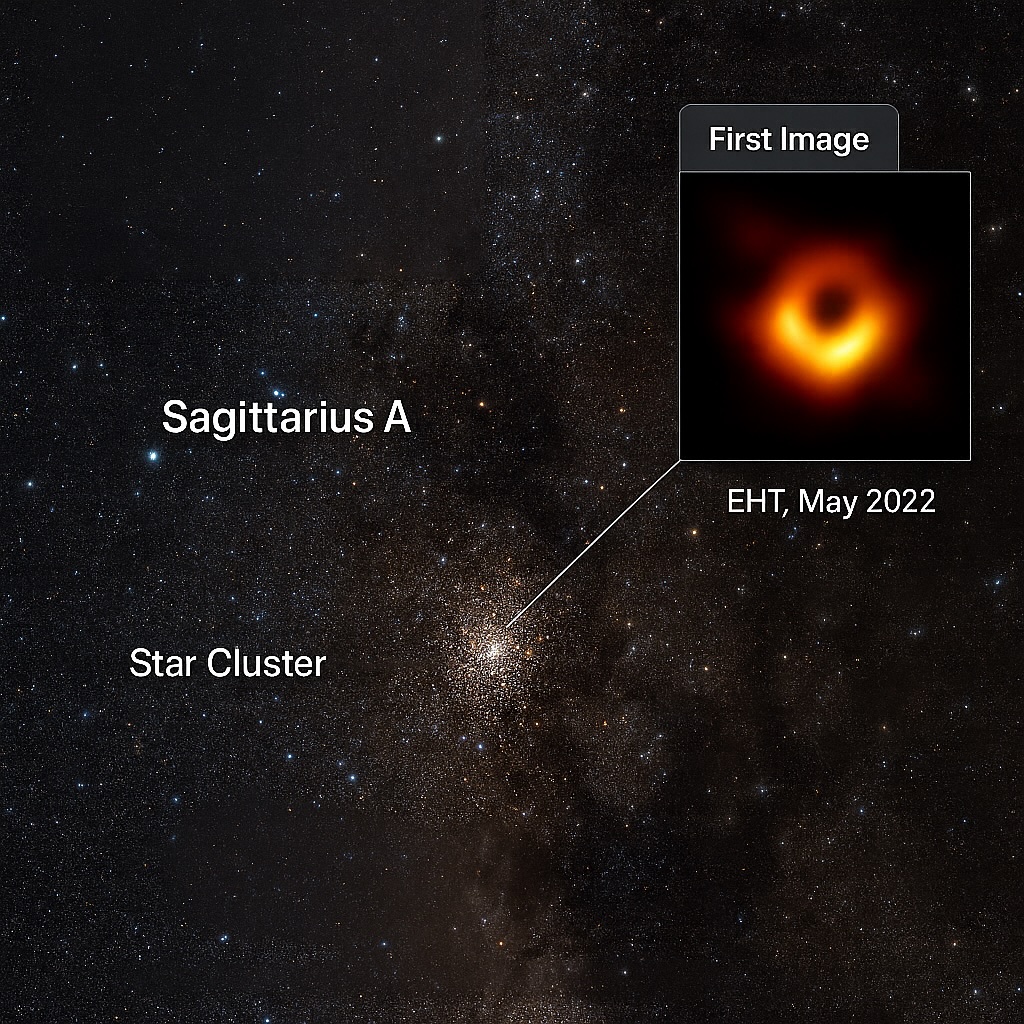
Sagittarius A (Sgr A) is a complex radio source at the center of the Milky Way galaxy (where we live!), containing the supermassive black hole Sagittarius A* (Sgr A*), which has a mass of about 4 million solar masses. Located in the direction of the Sagittarius constellation, Sgr A* was discovered by tracking the orbits of stars moving at high speeds around a dark, central object, a feat for which Reinhard Genzel and Andrea Ghez received the Nobel Prize in Physics.
1. Location & Nature
Sagittarius A is the bright, complex radio source sitting at the exact center of the Milky Way, roughly 26,500 light-years away in the constellation Sagittarius. At its heart lies Sagittarius A* — a supermassive black hole (SMBH) with a mass of about 4.15 million solar masses.
2. Discovery & Evidence
Astronomers detected its presence by tracking S-stars (notably S2) orbiting at extreme speeds around an invisible mass. These orbits, mapped over decades using high-precision infrared observations, confirmed that only a compact object as dense as a black hole could explain their motion. This work earned Reinhard Genzel and Andrea Ghez the 2020 Nobel Prize in Physics.
3. Size & Scale
Its event horizon (Schwarzschild radius) is about 12 million km across — just 17 times the diameter of the Sun. Despite its mass, Sgr A* is relatively quiescent, accreting matter at a very low rate compared to bright quasars like TON 618.
4. First Image
In May 2022, the Event Horizon Telescope (EHT) collaboration released the first-ever direct image of Sgr A*, showing a bright ring of radiation surrounding the black hole’s shadow — a landmark achievement in black hole imaging.
5. Astrophysical Laboratory
Because it’s the closest SMBH, Sgr A* is a perfect natural lab for studying: Strong-field general relativity (periapsis precession, gravitational redshift). Plasma physics near event horizons. Black hole accretion and flare activity on hour-scale timescales. Star formation and gas dynamics in extreme gravitational environments.
Bizarre mind bending facts about Black Holes
Time behaves very strangely around a black hole. Near the event horizon, time for an outside observer appears to slow down dramatically. From Earth, you’d see an astronaut falling toward a black hole slow to a crawl, frozen in time just above the event horizon — but from their perspective, they’d fall in immediately.
Gravity also acts very weird around the extreme environment of a black hole. Spaghettification happens because tidal forces stretch anything that gets too close into a long, thin “noodle.” This happens because gravity pulls much harder on the part of you closer to the black hole than the part farther away so your feet would be stretched first if you were falling in feet first.
Some theories suggest that all the information about everything that ever fell into a black hole is encoded on its two-dimensional event horizon — like a cosmic hard drive. This is called the Holographic Principle.
Around a spinning (Kerr) black hole, the ergosphere is a region where space-time itself is dragged around. In theory, you can drop in an object, split it, and extract more energy than you put in (the Penrose Process).
Some black holes launch plasma jets that travel near the speed of light and can stretch thousands of light-years across space called Relativistic Jets. Knowledge of how these jets function cloud get us to light-speed travel, or even teleportation! (if such a thing is possible)
Black Holes in Science Fiction and Pop Culture
Black holes often symbolize mystery, death, or oblivion — a place from which nothing returns.
Films
- Interstellar was perhaps the best depiction of a black hole to date, the glowing halo wrapping around the black hole is based on real relativistic light-bending simulations. Gargantua: One of the most scientifically accurate depictions of a black hole ever put on screen, thanks to physicist Kip Thorne who had a major part in Christopher Nolan’s film. The film shows astronauts experiencing hours near Gargantua while years pass on Earth — a direct result of general relativity.
- Event Horizon (1997) – Black hole drive accidentally opens portal to a hellish dimension.
- Star Trek (Multiple Series & Films) – Gravitational slingshots, singularity-based warp cores, “Star Trek: The Next Generation” episode Timescape features a collapsing star becoming a micro black hole.
- Stargate SG-1 (Ep. “A Matter of Time”) – Stargate opens near a black hole causing catastrophic time dilation.
- Lost in Space (Netflix, 2018) – Planet-threatening black hole as a central plot device.
- Futurama – Universe trash dumped into a black hole (“Bender’s Big Score”).
- Doctor Who – Black holes used as energy sources, time machines, and prisons (e.g., “The Impossible Planet” two-parter).
- Doctor Strange in the Multiverse of Madness – Collapsed star as a magical weapon.
- Thor: The Dark World – “Black hole grenades” that collapse matter into singularities.
- Rick and Morty – Multiple episodes riff on black holes, gravity, and spaghettification.
- The Expanse – Features a mysterious ring gate leading to a hub beyond normal space; black-hole-like physics are key to its functioning. (I recommend this one!)
Books & Literature
- Stephen Baxter — Manifold: Time – Micro black holes as tools for universe creation.
- Arthur C. Clarke — The Songs of Distant Earth – Black holes as background cosmic hazards.
- Gregory Benford — Cosm – Creating a baby universe inside a particle accelerator.
- Larry Niven — “The Hole Man” – Release of a micro black hole leads to disaster.
- Alastair Reynolds — Revelation Space series – Hard-SF use of black holes and relativistic space travel.
- Frederik Pohl & Jack Williamson — The Singers of Time – Alien civilizations manipulating black holes.
- John Wheeler & Kip Thorne (nonfiction) – Popularized black hole physics and helped inspire sci-fi authors.
- Dan Simmons — Hyperion Cantos – Farcaster portals and the TechnoCore manipulate singularities.
Games
- Elite Dangerous – Sagittarius A* faithfully rendered, gravitational lensing simulated.
- Outer Wilds – Black hole/white hole pair as puzzle mechanic.
- No Man’s Sky – Black holes as fast-travel network nodes.
- Mass Effect – Mass relays near black holes, plot-critical black hole in Mass Effect 2 Collector base.
- EVE Online – Wormholes and black-hole-like systems forming entire economies.
- Kerbal Space Program (mods) – Players experiment with gravitational wells and orbital mechanics.
- Destiny / Destiny 2 – Exotic weapons and lore reference singularities (“Graviton Lance”).
- Dead Space – Gravity and planet-fragment mechanics inspired by black hole-level pull.
- Control (Remedy) – Features altered world events and objects linked to gravitational anomalies.
- Star Wars: Knights of the Old Republic – Hyperspace travel and gravity wells as tactical weapons (Interdictor cruisers).
- Minecraft (mods) – Black-hole-like singularities as tools/weapons in modpacks like Applied Energistics.
Music & Cultural References
- Muse — Supermassive Black Hole – Rock anthem using a black hole as a metaphor for desire.
- Soundgarden — Black Hole Sun – Psychedelic metaphor about end-times and darkness.
- Public Enemy — Fear of a Black Planet – Political metaphor invoking cosmic imagery.
- Jean-Michel Jarre — Chronologie Part 6 – Synth track inspired by black-hole-like gravitational pull.
The Future of Black Hole Research
Now Event Horizon Telescope (EHT) – already gave us first images of M87* & Sgr A*. This will be pivotal for continuing to study black holes from space.
Next Generation EHT coming in late 2020, which will show matter swirling around the black holes
Black Hole Explorer (BHEX) – a proposed space telescope to zoom in even further (early 2030s if approved).
Now LIGO–Virgo–KAGRA are running their latest observing campaign (O4) through late 2025, catching dozens of black hole mergers.
LISA (2035) Space mission to “hear” supermassive black hole collisions.
Einstein Telescope / Cosmic Explorer (~2035) Next-gen ground detectors for much fainter signals.
Pulsar Timing Arrays: Already picking up a background hum of supermassive BH pairs across the universe.
Einstein Probe & SVOM (launched 2024): Catch tidal disruption events (stars torn apart by black holes).
Rubin Observatory (starting late 2025): Will flood astronomy with data about black hole feeding events and flares.
GRAVITY+ (2025): Will measure orbits of stars around Sgr A* even more precisely — strong tests of Einstein’s relativity.
SKA (early 2030s): First images in 2025; will study jets, galaxies, and find pulsars near black holes.
ngVLA (2030s): Next-gen VLA (very large array) in the US, for high-res radio views of black hole jets and feeding.
📚 References
Foundational Science & NASA Resources
- NASA – Black Hole Basics https://science.nasa.gov/astrophysics/focus-areas/black-holes (Introductory-level explanation of black holes, accretion disks, and event horizons)
- Chandra X-ray Observatory – Black Holes https://chandra.harvard.edu/xray_sources/blackholes.html (Deep dive into black hole detection via X-rays and binary systems)
- Event Horizon Telescope Collaboration https://eventhorizontelescope.org/ (Images of M87 and Sagittarius A*, plus technical details on how they were captured)*
Astrophysics & Relativity
- Einstein Online – General Relativity https://www.einstein-online.info/en/spotlight/black_holes/ (Max Planck Institute resource explaining spacetime curvature and event horizons)
- Stanford Gravity Probe B Project https://einstein.stanford.edu/ (Experimental confirmation of spacetime curvature and frame-dragging relevant to ergospheres)
- NASA – Time Dilation Near Black Holes https://www.nasa.gov/mission_pages/chandra/news/black-hole-time-dilation.html (Observational evidence of relativistic effects near black holes)
Black Hole Formation & Life Cycle
- European Space Agency (ESA) – Star Deaths & Supernovae https://www.esa.int/Science_Exploration/Space_Science/Black_holes_and_supernovae (Explains stellar collapse and birth of black holes)
- Harvard-Smithsonian CfA – Stellar Evolution https://lweb.cfa.harvard.edu/seuforum/stellar_evolution.html (Stellar mass thresholds for neutron stars vs. black holes)
Observational Evidence & Detection
- LIGO Scientific Collaboration – Gravitational Waves https://www.ligo.org/science/Publication-GW150914/index.php (First detection of black hole merger gravitational waves)
- ESA Gaia Mission – Galactic Center Mapping https://www.cosmos.esa.int/gaia (Precise measurements of stars orbiting Sagittarius A)
Advanced Topics
- Hawking, S. W. (1975). “Particle creation by black holes.” Communications in Mathematical Physics, 43(3): 199–220. (Original paper on Hawking radiation and black hole evaporation)
- Kip Thorne – Black Holes and Time Warps ISBN: 978-0393312768 (Excellent popular science book explaining black hole physics and relativity)
- Perimeter Institute – Black Hole Information Paradox https://perimeterinstitute.ca/black-hole-information-paradox (Current debates and theoretical work on quantum information & singularities)
